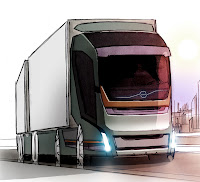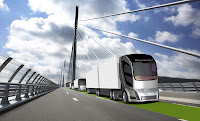
Swedish manufacturer Volvo Trucks recently unveiled the Volvo Concept Truck 2020 design concept, The Volvo Concept Truck 2020 displays a long distance vehicle, which can be combined in length, equipped with autopilot. The Volvo Concept Truck 2020 will be able to drive non-stop in nose-to-tail convoys that run at 90 km/h (56 mph) while the cars communicate with each other via a wireless connection.
Moving on to driver’s comfort, the driver’s seat looks more like a modern office chair with a thin ventilated mesh backrest. Behind the driver seat you will find a futon sofa which can be turned into a wide comfortable bed. The luxury experience is further complemented by the customizable lighting that can be changed as per in-cab tasks or resting. The driver may also control the privacy screening and blackout electronically.
Outside, the concept truck features LED headlamps and turn indicators that are integrated into the front of the vehicle. The rear-view mirrors have been replaced by cameras, while images are projected onto the inside of the windscreen.
The Concept Truck 2020 has rear-view cameras that project an image onto the inside of the windscreen and helps the driver to orientate better, LED headlamps and indicators, and collision protection panels on the truck's nose.















Press Release
TRUCKS OF THE FUTURE; CLOSER TO REALITY THAN YOU THINK
Progress is getting ever faster. In just ten years' time trucks are going to be a lot different to those of today. At least that is according to Rikard Orell, Design Director at Volvo Truck Corporation and one of the brains behind Concept Truck 2020, the Volvo Truck Corporation's bold vision for the future.
Long distance haulage for the future: long combinations, controlled by autopilot, driven non-stop in nose-to-tail convoys on green super-motorways linking the continents.
This is the vision of the future that generated the ideas behind the Volvo Concept Truck 2020 design concept. But will it really look like this in just ten years?
"That is the whole point," says Rikard Orell Design Director at Volvo Trucks. "Progress is getting ever faster. Because of this our vision for the future is not that far away. Much of the technology in the Volvo Concept Truck 2020 is already available; other technology needs to be developed. One needs to dare to stride firmly into the debate, demonstrating what one can and will do. Just tinkering at the edges runs the risk of progress slipping away."
Safer and more efficient commercial transport
As road transport expands it must also become safer and more efficient. Volvo's design concept contains ideas about how that can be achieved. Some of these ideas can be integrated into production today, while others are there to arouse interest and start a discussion.
One of the more startling ideas is to link vehicles together wirelessly into long road-trains that rush across the continents at 90 km/h (56 mph).
"This will be possible when the transport sector's vision of green corridors becomes reality," says Rikard Orell. "Here heavy goods vehicles are separated from other traffic, driving in their own lanes, rather like a railway, but without the rails."
There are many advantages. Road safety increases, transport services require less space and wear and tear on the roads decreases. Fuel consumption and CO2 emissions drop thanks to reduced drag when a truck is in the slipstream of the vehicle in front. In addition the driver can rest behind the wheel while the truck effectively drives itself. If this is counted as idle time, transport times can be cut, deliveries will be made more quickly and drivers can get back to their friends and families earlier.
Spacious and airy driver environment
The driver is at the centre of Volvo's world. It goes without saying that a design concept from Volvo Trucks contains a great many ideas about the development of the driver environment. In the Volvo Concept Truck 2020 the driver's environment is spacious, airy and free of disruption.
"We have replaced the traditional dashboard with a thin film panel on which information is tailored to suit the driver," says Rikard Orell. "The panel is operated like a touchpad, just like an iPhone. We have saved a lot of space that way."
Another space-saving idea is the sleek driver's seat with its thin, ventilated mesh backrest, more like a modern office chair than a traditional driver's seat. Behind the driver is a futon sofa which folds out into a wide, comfortable bed in the evening.
The lighting in the cab is divided into zones customised for the driver's various in-cab tasks, or for resting. Around the driver are large areas of glass providing good visibility out of the vehicle and even into it. This benefits eye contact between the driver and other road users preventing accidents. Privacy screening and blackout in the evening are also controlled electronically.
Aerodynamic collision protection
The design team also aimed for a sleek look for the exterior, reducing the perception of the vehicle's size. The LED headlamps and indicators are integrated into the front of the vehicle. The rear-view mirrors have been replaced by cameras that project their images onto the inside of the windscreen.
The lower section of the front of the vehicle features integrated collision protection projecting forwards about half a metre. This ‘nose' is gentler on oncoming cars in the event of a head-on collision and has also been shown to improve the aerodynamics of the vehicle.
As Rikard Orell points out, "Because the nose is a safety function, our starting point has been that it does not count as part of the maximum permitted vehicle length, just as rear-view mirrors today are outside the maximum permitted width."
Some things you just do not change. The ‘Globetrotter' sign on the roof is still there, but has been redesigned so that it harmonises with the lines of the vehicle and reduces drag. The driver can also change the text on the sign from the instrument panel.
The rear end is the next stage
So work on the external design focuses largely on aerodynamics, but by how much is it really possible to reduce drag on a truck ?
"We have come so far with the front of the vehicle that further changes to the basic shape provide only marginal improvements," says Rikard Orell. "However, a lot will happen when we start work on the design of the rear end of the vehicle. There is a great deal of untapped aerodynamic potential there."
and in 2020 this truck has been created!
ReplyDeletehttp://uniknya.com/2016/01/15/aneka-olahan-cincau-mangstab-dan-es-yang-bikin-teler/